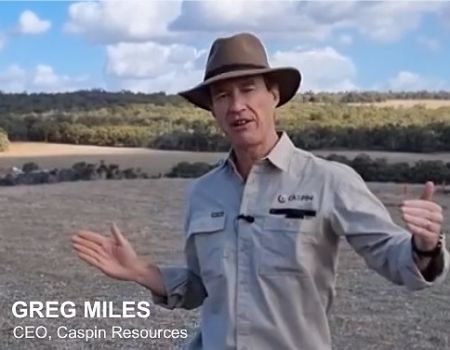|
For 2 years, Azure Minerals was exploring and discovering nickel in its project in Western Australia. |
The reality is, investing in junior explorers is a long journey usually -- and it's fraught with risks as the success rate for discovering an economic deposit is pretty small. It's a long shot.
By the way, pre-Covid, Azure was exploring for gold in Mexico for several years without resounding success. Junior explorers are a risky bet but those that discover economic deposits of minerals such as lithium are richly rewarded by the market. Photo: Caspin Resources
Junior explorers are a risky bet but those that discover economic deposits of minerals such as lithium are richly rewarded by the market. Photo: Caspin Resources
In addition, commodity prices can be volatile. That's why many exploration and mining stocks listed on the Australian Stock Exchange (ASX) are down roughly 30-50% year-to-date. That's a big hammering, unless you have deep pockets.
(Before you get disheartened, consider that the longer-term picture is very positive though: Minerals needed for the energy transition are widely expected to enjoy strong prices as a looming deficit in supply materialises).
And where there are discoveries, as they grow, there are sharp ups and downs in the market's sentiment towards, and valuation of, the stock.
In the case of a discovery of economic potential, the stock may behave as depicted in the chart below as it progresses to development of a mine and starts production.
To be sure, it's never always so predictable:  Source: Next Investors
Source: Next Investors
Clearly, that's not your typical stock chart for businesses in many non-mining industries such as food & beverage or manufacturing.
You may wonder: Which stage of a junior explorer's journey may one enter?
There's no answer that suits everyone, as it depends on many factors including:
| • The investor's risk appetite: The earlier he enters, the greater the potential reward -- or failure. Explorers that don't hit what they seek in the ground will grind at sub-$10 million market caps for years and dilute shareholders with fund raisings. • The investor's assessment of the rock chip sampling results and drilling results to-date. If he correctly assesses the significance of the results, he can decide to invest early or defer until further confirmation of an economic discovery. • Consider the financial resources of the company. Exploration eats up cash, and dilutive fund raising is par for the course. One of the worst buying times is after a stock price run-up (which may been manipulated) and just before a fund-raising is announced. |
With the above factors in mind, as an example, consider ASX-listed Caspin Resources. Its market cap is A$13 million at a recent stock price of 14 cents.  Is it an early big opportunity or not?
Is it an early big opportunity or not?
Investors with a big risk appetite and are able to judge the drilling results to-date as promising may think it's worth a bet now.
Others may decide otherwise, preferring to wait for more results from its work which has made initial discoveries of minerals such as nickel, copper and rare earths.
(For more, see: Eye on green energy metals: Will this junior explorer hit it big? Here are early drilling results)
Recently, it said it has detected presence of lithium in its grounds.
Says Caspin's MD, Greg Miles, who travelled to Singapore twice recently to meet investors: “When you go out into the frontiers, you never know what you’re going to find and we’ve been excited by a new rare earth discovery....what’s different about our discovery is that it’s got a really high proportion of heavy rare earths, which are much more valuable.”
More investors with non-mining backgrounds are turning to companies that range from junior explorers to near-term producers to actual producers -- especially on the ASX -- to ride on the global energy transition.
These minerals are needed in batteries for energy storage, electric vehicles, solar panels, and other clean energy technologies. An alternative to investing in junior explorers is, of course, the producers (example: US$16 billion market cap Albermarle). Then there are the businesses further downstream in the supply chain such as EV manufacturers. That's a story for another day. |
For more, see Caspin MD's latest video below:




